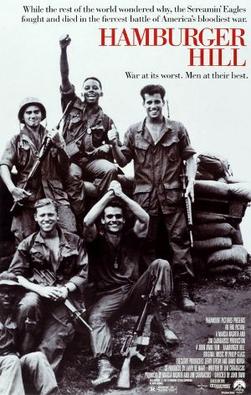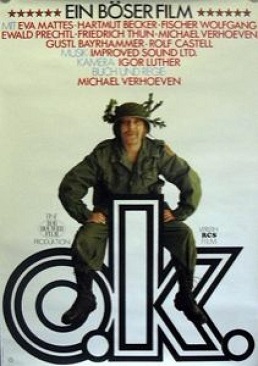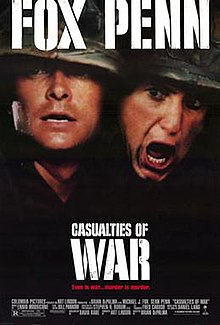
Platoon is a 1986 American war film written and directed by Oliver Stone, starring Tom Berenger, Willem Dafoe, Charlie Sheen, Keith David, Kevin Dillon, John C. McGinley, Forest Whitaker, and Johnny Depp. It is the first film of a trilogy of Vietnam War films directed by Stone, followed by Born on the Fourth of July (1989) and Heaven & Earth (1993). The film, based on Stone's experience from the war, follows a new U.S. Army volunteer (Sheen) serving in Vietnam while his Platoon Sergeant and his Squad Leader argue over the morality in the platoon and of the war itself.

Hamburger Hill is a 1987 American war film set during the Battle of Hamburger Hill, a May 1969 assault during the Vietnam War by the U.S. Army's 3rd Battalion, 187th Infantry, 101st Airborne Division, on a ridge of Dong Ap Bia near the Laotian border in central Vietnam. The ridge was a well-fortified position, including trenchworks and bunkers, of the North Vietnamese Army. U.S. military records of the battle refer to the mountain as "Hill 937," its map designation having been derived from the high elevation of the hill at 937 meters (3,074 ft).

The Battle of Ia Drang was the first major battle between the United States Army and the People's Army of Vietnam (PAVN), as part of the Pleiku Campaign conducted early in the Vietnam War, at the eastern foot of the Chu Pong Massif in the central highlands of Vietnam, in 1965. It is notable for being the first large scale helicopter air assault and also the first use of Boeing B-52 Stratofortress strategic bombers in a tactical support role. Ia Drang set the blueprint for the Vietnam War with the Americans relying on air mobility, artillery fire and close air support, while the PAVN neutralized that firepower by quickly engaging American forces at very close range.

We Were Soldiers is a 2002 American war film written and directed by Randall Wallace and starring Mel Gibson. Based on the book We Were Soldiers Once… and Young (1992) by Lieutenant General (Ret.) Hal Moore and reporter Joseph L. Galloway, it dramatizes the Battle of Ia Drang on November 14, 1965.

Tigerland is a 2000 American war drama film directed by Joel Schumacher and starring Colin Farrell. It takes place in a training camp for soldiers to be sent to the Vietnam War.

R-Point is a 2004 South Korean psychological horror war film written and directed by Kong Su-chang. Set in Vietnam in 1972, during the Vietnam War, it stars Kam Woo-sung and Son Byong-ho as members of the South Korean Army in Vietnam. Most of the movie was shot in Cambodia. Bokor Hill Station plays a prominent part of the movie, in this case doubling as a French colonial plantation. In 2011, Palisades Tartan re-released this film on DVD under the title Ghosts of War.
Thuy Thu Le is known for her appearance in the 1989 movie Casualties of War by Brian De Palma.
David William Rabe is an American playwright and screenwriter. He won the Tony Award for Best Play in 1972 and also received Tony Award nominations for Best Play in 1974, 1977 (Streamers) and 1985 (Hurlyburly).

Pierre Schoendoerffer was a French film director, a screenwriter, a writer, a war reporter, a war cameraman, a renowned First Indochina War veteran, a cinema academician. He was president of the Académie des Beaux-Arts for 2001 and for 2007.

Platoon Leader is a 1988 war film set in the Vietnam War and directed by Aaron Norris ; it stars Michael Dudikoff and Michael DeLorenzo and was filmed in South Africa. It is loosely based on James R. McDonough's memoir of the same name.

The Battle of Gang Toi was fought during the Vietnam War between Australian troops and the Viet Cong. The battle was one of the first engagements between the two forces during the war and occurred when A Company, 1st Battalion, Royal Australian Regiment struck a Viet Cong bunker system defended by Company 238 in the Gang Toi Hills, in northern Bien Hoa Province. It occurred during a major joint US-Australian operation codenamed Operation Hump, involving the US 173rd Airborne Brigade, to which 1 RAR was attached. During the latter part of the operation an Australian rifle company clashed with an entrenched company-sized Viet Cong force in well-prepared defensive positions. Meanwhile, an American paratroop battalion was also heavily engaged in fighting on the other side of the Song Dong Nai.

Operation Bribie, also known as the Battle of Ap My An, was fought during the Vietnam War in Phuoc Tuy province between Australian forces from the 6th Battalion, Royal Australian Regiment and two companies of Viet Cong from D445 Battalion, likely reinforced by North Vietnamese regulars. During the night of 16 February the Viet Cong attacked a South Vietnamese Regional Force compound at Lang Phuoc Hai, before withdrawing the following morning after heavy fighting with South Vietnamese forces. Two hours later, a Viet Cong company was reported to have formed a tight perimeter in the rainforest 2 kilometres (1.2 mi) north of Lang Phuoc Hai, near the abandoned hamlet of Ap My An. In response, the Australians deployed a quick reaction force. Anticipating that the Viet Cong would attempt to withdraw, as they had during previous encounters, forces from the 1st Australian Task Force were inserted to block the likely withdrawal route in the hope of intercepting and destroying them.

Brian Leroy Buker was a United States Army soldier and a recipient of the United States military's highest decoration—the Medal of Honor—for his actions in the Vietnam War.

o.k., sometimes spelled O.K., is a 1970 West German anti-war film written and directed by Michael Verhoeven. It was chosen as West Germany's official submission to the 43rd Academy Awards for Best Foreign Language Film, but did not receive a nomination. The film was also entered into the 20th Berlin International Film Festival. However, the competition was cancelled and no prizes were awarded, over controversy surrounding the film.
The incident on Hill 192 refers to the kidnapping, gang rape, and murder of Phan Thi Mao, a young Vietnamese woman, on November 19, 1966 by an American squad during the Vietnam War. Although news of the incident reached the U.S. shortly after the soldiers' trials, the story gained widespread notoriety through Daniel Lang's 1969 article for The New Yorker and his subsequent book. In 1970 Michael Verhoeven made the film o.k., based on the incident. In 1989 Brian De Palma directed the film Casualties of War, which was based on Lang's book.

The Battle of Suối Châu Pha was fought during the Vietnam War between Australian troops and the Việt Cộng. The battle took place during Operation Ballarat, an Australian search and destroy operation in the eastern Hát Dịch area, north-west of Núi Đất in Phước Tuy province. Following a covert insertion the day before which had caught a number of Việt Cộng sentries by surprise, A Company, 7th Battalion, Royal Australian Regiment had patrolled forward unaware of the presence of a large Việt Cộng main force unit nearby. Clashing with a reinforced company from the Việt Cộng 3rd Battalion, 274th Regiment, a classic encounter battle ensued between two forces of roughly equal size. Fought at close quarters in dense jungle amid a heavy monsoon rain, both sides suffered heavy casualties as neither was able to gain an advantage. Finally, after a battle lasting several hours, the Australian artillery proved decisive and the Việt Cộng were forced to withdraw, dragging many of their dead from the battlefield after having suffered crippling losses.

John Kizirian was a highly decorated member of the United States Armed Forces for over three decades and served during World War II, the Korean War, and the Vietnam War.

James C. McCloughan is a former United States Army soldier and a Vietnam War veteran. For his actions during the war, McCloughan was approved for the Medal of Honor by President Barack Obama and Secretary of the Army Eric Fanning in December 2016. McCloughan was presented the Medal of Honor on 31 July 2017 by President Donald Trump, the first such award of Trump's administration.

The Battle of Dương Liễu–Nhông Pass took place during the Vietnam War at Dương Liễu and Đèo Nhông, in the area of Phù Mỹ district, Bình Định province, between the 2nd Regiment of the South Vietnamese Liberation Army and 2 infantry battalions, 1 armored division of the Army of the Republic of Vietnam. The anniversary of this battle is usually counted according to the lunar calendar, and there are records that the battle took place from February 7 to February 8, 1965.

Rape during the Vietnam War, as well as other acts of wartime sexual violence, was committed against Vietnamese civilians by military personnel from the United States, South Korea, and other combatants. According to American academic Elisabeth Jean Wood, wartime rape was frequently committed by U.S. troops because their commanders tolerated them. Weaver stated that not only were documented crimes against Vietnamese women by United States military personnel ignored during the international legal discourse which occurred immediately after the war, but modern feminists and other anti-war rape campaigners, as well as historians, have continued to dismiss them.

















